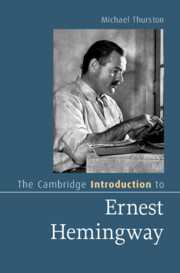Book contents
- The Cambridge Introduction to Ernest Hemingway
- The Cambridge Introduction to Ernest Hemingway
- Copyright page
- Dedication
- Contents
- Acknowledgments
- Introduction
- Chapter 1 Life
- Chapter 2 Contexts
- Chapter 3 Crafting a Style
- Chapter 4 Consolidating a Career
- Chapter 5 Men and Beasts
- Chapter 6 Men (and Women) at War
- Chapter 7 Last and Posthumous Works
- Chapter 8 Reception
- Works Cited
- Index
- References
Works Cited
Published online by Cambridge University Press: 15 September 2025
- The Cambridge Introduction to Ernest Hemingway
- The Cambridge Introduction to Ernest Hemingway
- Copyright page
- Dedication
- Contents
- Acknowledgments
- Introduction
- Chapter 1 Life
- Chapter 2 Contexts
- Chapter 3 Crafting a Style
- Chapter 4 Consolidating a Career
- Chapter 5 Men and Beasts
- Chapter 6 Men (and Women) at War
- Chapter 7 Last and Posthumous Works
- Chapter 8 Reception
- Works Cited
- Index
- References
Information
- Type
- Chapter
- Information
- The Cambridge Introduction to Ernest Hemingway , pp. 191 - 197Publisher: Cambridge University PressPrint publication year: 2025
References
Works Cited
Accessibility standard: WCAG 2.2 AAA
Content Navigation
Allows you to navigate directly to chapters, sections, or non‐text items through a linked table of contents, reducing the need for extensive scrolling.
Provides an interactive index, letting you go straight to where a term or subject appears in the text without manual searching.
Reading Order & Textual Equivalents
You will encounter all content (including footnotes, captions, etc.) in a clear, sequential flow, making it easier to follow with assistive tools like screen readers.
Visual Accessibility
You will still understand key ideas or prompts without relying solely on colour, which is especially helpful if you have colour vision deficiencies.
You benefit from high‐contrast text, which improves legibility if you have low vision or if you are reading in less‐than‐ideal lighting conditions.
